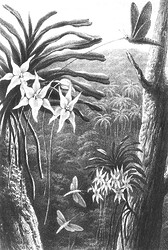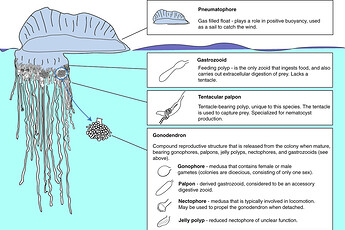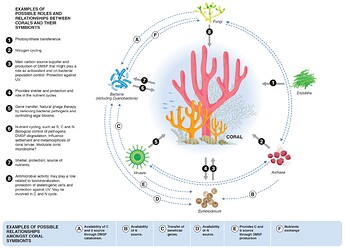Reservations and Preliminary Comments:
First of all - I’m not the best writer, so for this post I use Google Translate. This may not be the best, but it allows me to write faster than usual at the cost of accuracy, so I’m sorry if by chance and there are misunderstood things.
Second - this post was based on some of the things said before, so it may have been repeated, but I want to get into a topic that has been talked about before, so I’ll add links related to the topic:
Links / Past discussions
Possibilities Considering Symbiosis
Symbiosis
Will you be able to play as a parasitic life form (Halo's Flood for example)
Third and final - this post is not going to talk about eusocial creatures, since it’s spoken several times, and it’s not going to be the focus.
if u want to see want its talikng about that topic, see there:
Introduction
There are a huge variety of life-sharing types and different forms of ways to survive: some produce their own food, some prey on them and some eat what is left of them or what they do not need. These are autotrophs, heterotrophs and decomposes respectively.
But there are also life forms that exploit others - both as cooperation, and in more selfish ways, or even as transportation.
Every living thing does everything that nature, its generations and its arsenal survive in a world where there are other entities competing for the same needs, or at their expense.
But these are most of us we know - predators, prey, parasites, symbiotes or the like. But after I went to check on something, I discovered that there is something here that we are ignoring (at least in this forum): another group that takes this whole thing mentioned earlier a step further.
I call them here “complex beings”, or in other words - complete dependence: those who are so dependent on each other that if one of them disappears, the other will also disappear.
An excellent example are the huge variety of mouth shapes of the hummingbird, or according to Darwin’s case about which moth or butterfly can suck nectar from the Angraecum sesquipedale orchid that is too long for a regular butterfly to get there. (The species that are able to do this are called sphinx moths for those who are interested).
These species are called “specialized species” - species that over the course of evolution, began to specialize in a very focused niche. The longer this balance exists, the more dependent the species become. Such acquaintances know of a wide variety of species, especially in places where there is great competition or in case of lack of competition at all, in case of the big panda with the bamboo.
But all “specialized species” is just one point off the spectrum that I define as “complex creatures.”
On this topic, I want to describe parts of this spectrum, how and whether it is possible or worthwhile to add them to the game.
Type one: Specialized species
As described in the introduction, complex species are species that specialize in a particular niche.
This does not necessarily mean that it is this species that should be dependent “only” on other creatures. These can be species that are either specially adapted to their environment or that feed on one type or a close group of creatures.
Creatures that adapt to such a level of focused environment are for example paradise birds, great pandas and endemic species. Most of them are endangered today due to human intervention and destruction of living environment too fast for them to adapt, compared to general creatures or those that adapt quickly such as raccoons, mice and belgiumroaches.
These points I touch on are familiar cases, but do not always happen. But these species almost always become extinct first when an extinction event occurs.
Such species in our game for example already exist at one level or another:
Autotrophic species, for example, use only iron to produce glucose. But what happens if it disappears in one moment and unexpectedly?
He will probably end his game in an instant and cause the player to rage quit.
I think creatures on this subject on the one hand very much should have been like this: a species that specializes specifically in hunting one type or similar of another creature or one that only exists in one area. This will add depth to the game, especially in the multicellular stage or awareness.
But on the other hand, this option should always be available to the player: both as a challenge and as he sees fit and should not limit such an option. But you should at least warn him that this is a dangerous move, or not.
This is a situation that already exists in the game and I think it’s worth leaving it as it is, but getting Auto-evo to try to create creatures like that for the world to feel more alive.
This is one point on the spectrum that at least exists in some way, but now I want to talk about types that have not been mentioned before and we should focus on them in depth.
Type two: Colonial creatures
I am not talking here about creatures that live in colonies or bands or in the eusocial system, I am talking about Modular organisms colony.
By definition, this is a colony of clones that each zygote has begun to take on a different role that contributes to the colony in general. Or in other words, multicellular in an additional step.
That it is a species in which during evolution, they seem to have gone through another stage and started taking additional specialties, for example some started collecting food while others started to specialize in movement.
Creatures in this field are the Portuguese man o 'war, Volvox and many species of the Siphonophorae family.
Species of this type undergo a special kind of way of reproduction: usually either one species, or a group of species that pass their gamut together to create a new colony, adding a special field to play and recognition to the great variety of life
Such species can be a really interesting addition, but not a necessity. But since we have already done something similar with the multicellular prototype, something similar can also be done for creatures of this type, only with additional steps.
But all the creatures most of this kind do not have great intelligence, but it is not impossible that such a creature can be intelligent or the complexity of the colony is also complex.
But this type of species is a larger stage of “specialized species”, but what happens if 2 or more different types of species become too dependent on each other?
Type three: Complex symbiosis
Complex symbiosis is by definition: another stage in symbiosis - at such a level that they are too dependent on each other that if they were defined as one creature it is forgiven.
Such creatures are such a deep and dependent collaboration that if they were removed they would both be dead.
There are 2 types of complex symbiosis:
Externally such as colony ants leaf cutters, mastigias etc.
And internally such as corals, lichens and intestinal bacteria of humans (although some can manage on their own)
Complex external symbiosis is defined as 2 or more species being in complex symbiosis under external conditions, such as when leaf-cutting ants grow their fungi, at some point in evolution the fungus they grow and the ants that grow it hang down to their biophysical level so they cannot be separated and survive alone.
Complex internal symbiosis is defined as 2 or more species being in complex symbiosis under the conditions that they are in the body of another living creature. For example, acne consists of 2 types of creatures: algae and fungus. As the algae provides the fungus with sugar and preservatives while the fungus tells the algae shelter, water and minerals from the environment, they have become inseparable to the level of their reproduction. Another example is coral - their color comes from a symbiotic bacterium that helps them obtain sugar through photosynthesis, similar to lichens. And this is also the reason when coral bleaches, it means that it has lost its symbiote and it dies as a result (white is the carbonated calcium used as their skeleton).
How do you get them into the game? It’s just like any other symbiosis when planned earlier, but I here recommend that if by chance and add something like this, you should let the player choose for example which symbiote he wants to be from a list of living creatures in his area, as in the menu.
But for complex symbiosis there is a price of dependencies and the conditions of the 2 species or more need to be balanced enough for them to survive together. After all there is always the option that one species was dependent on another creature while the other could manage on its own. This type I call “unilateral complex symbiosis” - just like in the gut bacteria in many creatures: we can not digest some of the food on their own, but they can do fine without us (and even eat them if they die), but it requires another important that may One can even give up this kind of symbiosis, but it is up to the decision of the game staff.
Type Epsilon: Commensalism and parasitic dependencies - The nature of evolutionary concessions
Why do I define them in epsilon and not in a regular number? Because I define them as multidisciplinary in the spectrum and not defined at one point.
I will give an example: there is a parasitic creature called Henneguya zschokkei, an animal close to jellyfish that lives in salmon, and the conditions there are not the best for parasites in terms of environment, but in terms of food, there are plenty there. And in order to live there, he had to give up something that sets all animals apart - the ability to breathe oxygen.
This waiver basically falls into 2 categories - “specialized species” and complex symbiosis (in this case parasites). Parasites are usually species that specialize in hunting and feeding or recovering in another life creature, but this species has taken it a step further to such a level that it has completely given up on a very important trait.
This is an evolutionary concession, which exists in every creature on this spectrum in general, and repeats every category here - it gives up one trait it needs in order to survive in exchange for another creature to fulfill its role or to adapt itself to the environment. This can be said to omit features in additional steps.
Commensalism is a case where one creature receives something while another creature is not affected by it for better or worse. A common case of this is the use of other creatures as a way to move from place to place, such as thorny plants that use mammalian hairs to spread their seeds or insects or frogs that ride on larger creatures to move from place to place without moving through dangerous areas.
Why do I mention it? Because even this is able to go into a state of parasites or symbiosis under certain conditions and even reach an extreme state of the categories I mentioned earlier and it is not something worth underestimating.
Is it worth adding Complex collaborations?
Here I speak on my own behalf, and if there is anyone who has a different opinion, feel free to express here or anywhere else.
Having presented what came to my mind, I want to think about it for a moment:
Is it worth it or unnecessary to add these modes to the game? And even if so, is it possible?
In my opinion and from what I have written on topics in each one, I here represent them as a general set of extreme or complex symbiosis states, and here my answer is that it is worth adding them to the game: it was interesting to give the game complex life forms that can surpass any imagination, similar to what we have in real.
But on the other hand, I feel that at least some of the things were a programming nightmare or even impossible at the level of accuracy, and not to mention the player’s experience if he wants to play something like that, so I want such a thing not to come into play in the known future.
But it’s quite worth talking about such a thing to come up with that there are other things that can be done.
Summary
The topic briefly discussed for those who are interested:
- Precedent for complex forms of symbiosis
- What is a complex symbiosis?
- What are specialized species and what do they look like in the game
- Complex colonies and whether it is worth putting them into play
- What types of acute symbiosis are there
- What about different types of relationships between creatures such as parasites and transition between creatures
- Is it worth putting all this stuff into Thrive?
conclusion
I raised this issue because I feel it is lacking in reference to a complex issue like this (on the symbiosis side, I’m talking about a variety of complex symbiosis to an inseparable level) and I just want to bring it up and what I have in mind.
I hope you enjoy my scribbled topic.


